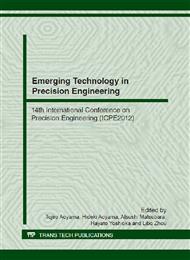[1]
N. Nakajima, N. Narutaki, Machining Technology, Corona publishing Co.Ltd., Japan, 1983, pp.181-185
Google Scholar
[2]
S. Hiroi, Y. Yamanaka, Cutting fluid and Grinding fluid, Saiwaishobo Co.Ltd., Japan, 1982, pp.244-264
Google Scholar
[3]
TECHNICAL RESEARCH INSTITUTE Japan Society for the Promotion of Machine Industry, Material Processing Data File Text Vol:15 (Grinding), TECHNICAL RESEARCH INSTITUTE Japan Society for the Promotion of Machine Industry, Japan, 2002, pp.32-33
Google Scholar
[4]
N. Nishikawa, S. Tsukamoto, K. Ohashi, T. Nakajima, T. Iyama, M. Mizuno, Y. Ota, T. Kubo, Basic Investigation of Environmental Harmonic Machining-Examination of various low pollution machining methods and effectiveness verification of half underwater grinding-, J. Environ. Conserv. Eng., 38, 6 (2009) pp.415-423 (in Japanese).
DOI: 10.5956/jriet.38.415
Google Scholar
[5]
S. Tsukamoto, N. Nishikawa, K. Okamoto and K. Ohashi, Development of the Electricity Rust Preventive Machining Method in Surface Grinding, Adv. Abras. Technol. VI Key Eng. Mater., Vols. 257-258, (2004) pp.483-488.
DOI: 10.4028/www.scientific.net/kem.257-258.483
Google Scholar
[6]
N. Nishikawa, S. Tsukamoto, K. Ohashi, R. Miyake, T. Iyama and M. Mizuno, Development of Electric Rust Prevention Machining Method in End Mill Cutting-Environmental Harmonic Machining Using Water in Cutting Machining-, J. Environ. Conserv. Eng., 37, 4 (2008) pp.274-281 (in Japanese).
DOI: 10.5956/jriet.37.274
Google Scholar
[7]
N. Nishikawa, Y. Sato, T. Katou, K. Karita, T. Iyama, M. Mizuno, N. Yoshihara, Y. Hagihara and S. Tsukamoto, Development of electric rust preventive machining method Rust prevention of workpiece and machine body, J. Jpn. Soc. Abras. Technol., 55, 3 (2011) pp.167-172 (in Japanese).
DOI: 10.4028/www.scientific.net/amr.325.699
Google Scholar
[8]
N. Nishikawa, K. Ohashi, M. Sudoh, S. Tsukamoto, Development of electric rust preventive storage method in water-Proposal of metal parts storage using water without rust preventive agent or oil-, J. Environ. Conserv. Eng., 35, 5 (2006) pp.371-377 (in Japanese).
DOI: 10.5956/jriet.35.371
Google Scholar
[9]
N. Nishikawa, Y. Sato, T. Katou, K. Karita, T. Iyama, M. Mizuno, N. Yoshihara, Y. Hagihara and S. Tsukamoto, Development of electric rust preventive machining method-Proposal of the machining water recycling system-, J. Jpn. Soc. Abras. Technol., 54, 10 (2010) pp.603-606 (in Japanese).
DOI: 10.4028/www.scientific.net/amr.325.699
Google Scholar
[10]
N. Nishikawa, Y. Sato, T. Kato, K. Karita, Y. Hagihara, N. Yoshihara, H. Okawai, H. Kato, T. Iyama, M. Mizuno and S. Tsukamoto, Development of Electric Rust Preventive Machining Method -Water using for Machining, Improvement of Water Recycle System-, Adv. Mater. Res., Vol. 325, (2011) pp.699-704.
DOI: 10.4028/www.scientific.net/amr.325.699
Google Scholar
[11]
N. Nishikawa, Y. Sato, K. Kudou, T. Murase, Y. Hagihara, N. Yoshihara, H. Kato, H. Okawai, K. Karita, T. Iyama, M. Mizuno and S. Tsukamoto, Development of Electric Rust Preventive Machining Method -Advancement and Verification of Water Recycle System-, Proc. of ABTEC2011, Aichi, Japan, (2011) pp.425-430 (in Japanese)
DOI: 10.4028/www.scientific.net/amr.325.699
Google Scholar
[12]
N. Nishikawa, Y. Sato, K. Kudo, T. Murase, T. Sawa, H. Kato, N. Yoshihara, H. Okawai, K. Karita, T. Iyama, M. Mizuno and S. Tsukamoto, Development of Electric Rust Preventive Machining Method -Correspond to Difference of Water in World: Use of Deionized Refined Water-, Adv. Mater. Res., Vol. 497, (2012) pp.365-372.
DOI: 10.4028/www.scientific.net/amr.497.365
Google Scholar
[13]
N. Nishikawa, Y. Sato, K. Kudo, T. Murase, T. Sawa, H. Kato, N. Yoshihara, H. Okawai, K. Karita, T. Iyama, M. Mizuno and S. Tsukamoto, Development of Electric Rust Preventive Machining Method -Correspond to Difference of Water in World: Use of Adjusted Synthesized Water-, Adv. Mater. Res., Vol. 497, (2012) pp.373-381.
DOI: 10.4028/www.scientific.net/amr.497.373
Google Scholar
[14]
H. H. Uhlig and R. W. Revie, Corrosion and corrosion control. 3rd ed., Sangyotosho Co.Ltd., Japan, 1989, p.59, p.217
Google Scholar


